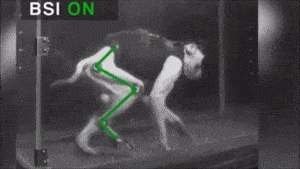Scientists are one step closer to creating a viable road to recovery for people who are paralyzed due to a spinal cord injury.
Paralyzed monkeys with spinal cord injuries were able to regain the ability to walk with the help of a wireless chip implanted in the brain that communicates with the spinal cord below the injury, according to a newly published report in the journal Nature.

“The primate was able to walk immediately once the brain-spine interface was activated,” said study co-author Erwan Bezard of Bordeaux in a statement. “No physiotherapy or training was necessary.”
This new advancement is unlike any other technology because it focuses on the monkey’s lower body and uses a wireless system to connect the two. A computer decodes the brain signals and then sends them to the spinal cord, but a wearable device that functions as a translator is possible to create.
Related: 3D-Printed Blood Vessels Successfully Implanted Into Monkeys
“It will take at least another decade in order to achieve the full translation in humans, with no guarantee whatsoever that it will be a successful endeavor,” said Gregoire Courtine, a neuroscientist at the Swiss Federal Institute of Technology and a co-author of the study.
Even though researchers say they are still 10 years away from adapting this new technology to humans, researchers are encouraged by the study’s results.
“I don’t imagine someone walking down the street with a brain-spine interface. That’s a bit extravagant at this stage. But in the next five years, someone with a spinal injury could have a better recovery after being implanted with this and having robot-assisted rehabilitation,” Courtine told The Guardian.

Spinal cord injuries are caused by a blow to the spine, which can then break or dislocate bones in the spine. As a result, essential nerves are damaged and are no longer able to carry messages between the brain and the rest of the body, leaving a person paralyzed. According to the World Health Organization, between 250,000 to 500,000 people worldwide suffer a spinal cord injury each year.
The new system was able to re-establish that pathway for communication between the brain and spinal cord for the monkeys, but scientists are presented with another set of obstacles before this technology is ready for human use. Scientists still need to do more work on motor skill issues such as balance, steering, and obstacle avoidance, which were not addressed in this recent study. However, the components of the wireless device that were put in place for the monkeys has been approved for humans.
“For the first time, I can imagine a completely paralyzed patient able to move their legs through this brain-spine interface,” said Jocelyne Bloch, the lead neurosurgeon on the project.
However, there’s a dark side to this breakthrough technology — the monkeys used in the study were deliberately paralyzed in their back right leg. The researchers involved in the study were based in Europe, but due to restrictions from the European Union, traveled to China to conduct their experiments.
Related: ALS Patient Designs Home He Controls With His Eyes
Danielle Tarasiuk is a multimedia journalist based in Los Angeles. Her work has been published on AllDay.com, Yahoo! Sports, KCET, and NPR-affiliate stations KPCC and KCRW. She’s a proud Sarah Lawrence College and USC Annenberg alumn.


![How To: ‘Fix’ Crepey Skin [Watch]](https://cdn.vitalupdates.com/wp-content/uploads/2017/05/bhmdad.png)












